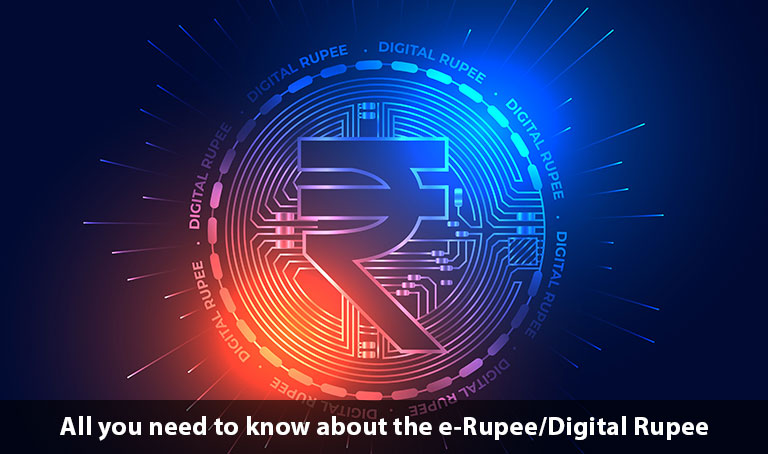All you need to know about the e-Rupee/Digital Rupee
Updated On : Dec 2022
On August 2, 2021, the Central Bank Digital Currency (CBDC) was launched by Prime Minister Narendra Modi. A cashless and contactless instrument for digital payment, the digital rupee or e-RUPI is designed to play a pivotal role in making direct benefit transfer (DBT) more effective. This digital payment solution provides a new dimension to digital governance and, based on digital transactions fused with technology, it is aimed at connecting people’s lives in the sub-continent.
India has been in the waves of a digital revolution over the last few years, and nothing more than digital payment has changed the lives of people and improved their standards of living. The e-RUPI has been launched to promote financial inclusion, create greater resilience for domestic payment systems, and foster more competition. The e-RUPI will bring better access to money, efficient payments, and lower transaction costs.
What is the e-RUPI
- The e-RUPI is a one-time cashless and contactless digital voucher in a pre-paid form that is received on a mobile device as an SMS or QR code and can be redeemed without the use of a card, any digital payments app, or access to internet banking.
- The NPCI (National Payment Corporation of India) has developed the e-RUPI on its UPI platform, in collaboration with the Department of Financial Services, the Ministry of Health & Family Welfare, and the National Health Authority.
- Through the e-RUPI, the sponsor of services will be connected with the beneficiaries and service providers digitally without any kind of physical interface.
- e-RUPI is prepaid in nature, and the payment to the service provider will be made after the completion of a transaction.
- This platform can also be used for providing drug and nutritional support services.
- The RBI has defined the digital rupee into two categories: retail and wholesale, based on the usage, the functions performed, and accessibility.
- The retail e-RUPI is primarily meant for retail transactions and can be used by the common retail customer for customer transactions with merchants and one-person-to-person transactions.
- The wholesale e-RUPI is designed for restricted access to select financial institutions. It can transform the settlement systems for financial transactions by banks in the government securities (G-Sec) segment, inter-bank market, and capital market, making it more efficient and secure in terms of operational costs, use of collateral, and liquidity management.
The Government of India took a major step on November 1, by launching the e-RUPI for the wholesale segment to settle secondary market transactions in government securities. After a month of e-RUPI transactions in the wholesale segment, on December 1, the RBI released the e-RUPI for retail customers and merchants in four cities on a pilot basis.
Significant Features
- The pilot initially covered four cities - Mumbai, New Delhi, Bengaluru, and Bhubaneswar, with plans to later extend to Ahmedabad, Gangtok, Guwahati, Hyderabad, Indore, Kochi, Lucknow, Patna, and Shimla.
- The pilot covers these locations in a closed user group (CUG) of participating customers and merchants.
- The RBI has identified eight banks for phase-wise participation, with the first phase starting with the State Bank of India, ICICI Bank, Yes Bank, and IDFC First Bank. In the second phase of the pilot, the Bank of Baroda, Union Bank of India, HDFC Bank, and Kotak Mahindra Bank will join.
- The pilot aims to test the sturdiness of the entire process, from digital rupee creation and distribution to retail usage, in real-time.
- e-RUPI would have the same denominations as the current paper currency and coins. It would be distributed through intermediaries, i.e., banks.
- Users will be able to transact with e-RUPI through a digital wallet offered by the participating banks and stored on mobile phones and devices.
- Transactions can be either person-to-person (P2P) or any person to merchant (P2M).
- Merchant payments can be made by scanning QR codes at merchant locations.
- The e-RUPI offers physical cash features like settlement finality, trust, and safety.
- The e-RUPI does not earn interest with the facility of being converted to other forms of money, such as deposits with banks.
The road ahead
With the learnings from the pilot launch, the RBI plans to bring in further improvement and sophistication by leveraging the country’s strong digital infrastructure. The e-RUPI offers practical anonymity for small-value transactions while it improves transparency in money flows and also reduces currency substitution. With more banks added to the list, there will be greater financial inclusion and resilience for domestic payment systems.
Nelito offers customized solutions & services for its clients from finance and other sectors. To know more about it, write us at marketing@nelito.com or visit us here.


Comments :